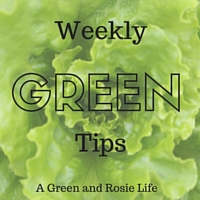Week 47 - How to have a Green Lawn
Having a lawn is much greener (literally and environmentally) than a hard-surfaced garden but is is still not without sustainability problems. There is the power to mow it and many lawn owners throw all sorts of chemicals on their lawns. As ever though, there are plenty of simple steps you can take to have the greenest green lawn.
7 Tips to Grow a Green Lawn
1. Cut the grass longer
Unless you are centre court at Wimbledon you really do not need to mow your grass so short. Cutting it no shorter than 6cm (2.5") will keep it looking green with less energy expenditure and it will survive any periods of drought much better.
2. Leave the clippings as fertiliser
When you mow, so long as there are not too many, leave the clippings to fall back into the lawn and they will act as a natural fertiliser. If there are lots though, then they are better composted but do make sure you mix the clippings with lots of drier material such as leaves or paper/cardboard to stop your heap becoming a black, sludgy mess!
3. Avoid all Lawn Chemicals
Do not use chemical fertilisers or weed killers on your lawn - rake out moss and dig our individual dandelions and large weeds ... and try to be a bit less worried if the odd weed takes up residence. I love seeing daisies in lawns and I let our dandelions flower once in spring to collect their petals for dandelion jelly. To feed your lawn rake in a fine, natural compost.
4. Make a meadow or area for veg
Why not let some of your lawn grow long and make a wild flower meadow? This is absolutely fabulous for bees, butterflies and other beneficial insects which in turn feed the birds. And a meadow in full flower is simply stunning to look at. If you can't give up a whole area for a meadow (and it only needs to be small) then leave a strip of grass in front of hedges/walls to grow long. This will be a great habitat for all sorts of creatures and all you need to do is cut it once in the autumn.
5. Grow Veg not Grass
You must know how wonderful fresh vegetables taste so you can turn a small section of your lawn into a veg patch and grow your own.
6. Do Not Water the Lawn
Even in a drought when the lawn starts to turn brown, the grass is not dead and in almost all cases it will green up when the rain falls again. If you absolutely cannot go without watering then make sure you water thoroughly just once every 7-10 days and allow the water to penetrate deep down and encourage strong, deep roots. Watering only the surface every day will do more harm than good and be a waste of valuable water. Avoid watering in the heat of the day when the grass can be scorched and water loss to evaporation will be higher.
7. Invest in a Push Mower
If your lawn isn't too huge then the greenest thing you can do is invest on an old fashioned rotary push mower. The quality of the cut is way better than any electric or petrol mower and you'll get a great work out every time you mow the grass.
Have you mown your lawn yet this year? I have and as a result I have some very happy pigs who get the extra grass clippings:
Have you seen all the other posts in my #WeeklyGreenTips series? Click on "Weekly Green Tips" in the labels section in the right hand column for loads more green inspiration.






I mowed my lawn yesterday; half is probably made up of moss, the other half dandelions and daisies! Our lawn is never going to be perfect but I don't stress too much.
ReplyDeleteGreat tips! I do most of these except having a push mower - we have about a 1/2 acre and it is on a hill so I don't think it would be really hard for my husband to use a hand push mower. Sharing on twitter & pinning. Visiting from #WasteLessWednesday Have a healthy, happy & blessed day!
ReplyDeleteI made hubby get a push mower while in Hawaii, but our tiny grassy area was small, but uneven so it was hard to cut. We don't water our "lawn" but it's mostly weeds and not actual grass anyway. Thanks for sharing on the Waste Less Wednesday Blog Hop!
ReplyDelete